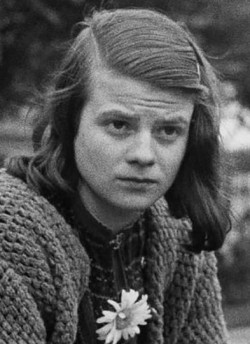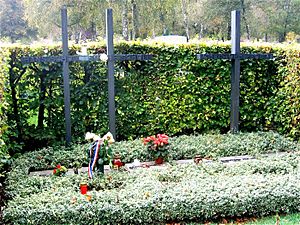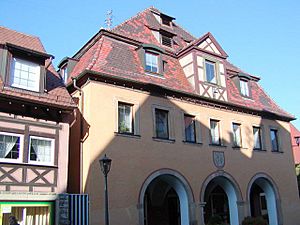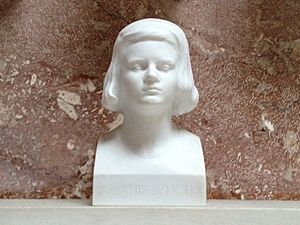Sophie Scholl facts for kids
Quick facts for kids
Sophia Magdalena Scholl
|
|
|---|---|

Sophie Scholl in 1942
|
|
| Born |
Sophia Magdalena Scholl
9 May 1921 Forchtenberg, Weimar Republic
|
| Died | 22 February 1943 (aged 21) Stadelheim Prison, Munich, Nazi Germany
|
| Cause of death | Execution by guillotine |
| Resting place | Cemetery at Perlacher Forst, Munich, Germany |
| Nationality | German |
| Education | Ludwig Maximilian University of Munich |
| Occupation | Student, political activist |
| Parent(s) |
|
| Relatives |
|
Sophia Magdalena Scholl (born May 9, 1921 – died February 22, 1943) was a brave German student. She was an activist who stood up against the Nazis in Nazi Germany.
Sophie was part of a secret group called the White Rose. This group used peaceful ways to fight against the Nazi government. She was caught giving out leaflets (small papers) that spoke out against the war at the University of Munich. She was with her brother, Hans. Because of this, she was executed by a machine called a guillotine. Since the 1970s, many people have remembered Sophie Scholl for her important work against the Nazis.
Contents
Sophie Scholl's Early Life
Sophie Scholl was born in Forchtenberg am Kocher, Germany. Her father, Robert Scholl, was a politician who did not agree with the Nazis. He was the mayor of her hometown. Sophie was the fourth of six children.
Her brothers and sisters were:
- Inge Aicher-Scholl (1917–1998)
- Hans Scholl (1918–1943)
- Elisabeth Hartnagel-Scholl (1920–2020)
- Sophie Scholl (1921–1943)
- Werner Scholl (1922–1944)
- Thilde Scholl (1925–1926)
Sophie grew up in the Lutheran church. She started school at age seven and learned easily. Her family moved to Ludwigsburg in 1930, and then to Ulm in 1932.
When Sophie was 12, she joined the Bund Deutscher Mädel (League of German Girls). This was a group for girls, and most of her classmates joined too. But Sophie soon started to question what the group stood for. She knew her father, friends, and some teachers did not like the Nazis. Her brother Hans, who was once very excited about the Hitler Youth, also became unhappy with the Nazi Party.
In 1937, her brothers and friends were arrested. This made a big impact on Sophie. She loved to draw and paint. She also became very interested in philosophy (thinking about life's big questions) and theology (the study of religion).
In 1940, Sophie finished high school. She wanted to be a kindergarten teacher. She hoped this job would count as a special service needed to go to university. But it did not. So, in 1941, she had to work for six months in a special war service program. This program was like military training. It made her think even more about the political situation. She started to practice passive resistance, which means resisting without violence.
In May 1942, Sophie started studying biology and philosophy at the University of Munich. Her brother Hans was already studying medicine there. He introduced her to his friends. This group of friends loved art, music, books, and thinking about big ideas. They also enjoyed hiking, skiing, and swimming.
While in Munich, Sophie met important thinkers like Carl Muth and Theodor Haecker. They often talked about how people should act when living under a dictatorship (a government with one leader who has total power). In the summer of 1942, Sophie had to work in a factory. At the same time, her father was put in prison for saying something critical about Adolf Hitler.
How Religion Guided Sophie Scholl
Religion was very important to Sophie Scholl. She often wrote letters to her boyfriend, Fritz Hartnagel. In these letters, she talked a lot about her faith. She even gave him books about "theology of conscience." This idea means that your inner sense of right and wrong, guided by your beliefs, tells you what to do. During her questioning by the police, Sophie said that her conscience made her stand up against the Nazis peacefully.
The White Rose Group
Sophie's brother, Hans Scholl, started to question the Nazi government around 1940. When he was a student at the University of Munich, he met people who helped him think more about religion and philosophy. Hans gathered friends who thought like him, including Alexander Schmorell and Willi Graf. They decided to fight the Nazis peacefully. They wrote and printed leaflets (small papers) that asked people to resist the Nazi government. They called themselves the White Rose.
The White Rose group began their activities in June 1942. Hans Scholl and Alexander Schmorell wrote the first four leaflets. They used quotes from the Bible, famous thinkers like Aristotle, and well-known German poets like Goethe and Schiller. They hoped these ideas would convince smart Germans to join their cause. They left these leaflets in public phone booths, mailed them to professors and students, and sent them to other universities.
Sophie likely learned about the White Rose in July 1942. But some think she might have known earlier. She asked her boyfriend if he could help her get a special pass to buy a duplicating machine. This machine was needed to print the leaflets. Sophie became a very important part of the group. As a woman, she was less likely to be stopped and searched by the SS (the Nazi police force).
Arrest and Execution
On February 18, 1943, Sophie and Hans Scholl went to the University of Munich. They had a suitcase full of leaflets. They quickly dropped stacks of them in the empty hallways for students to find. As they were leaving, they saw some leaflets left in the suitcase. Sophie decided to throw the rest of them from the top floor down into the main hall.
A university worker named Jakob Schmid saw Sophie throw the leaflets. He was a strong supporter of the Nazis. He reported Hans and Sophie Scholl to the police.
The police, called the Gestapo, arrested Hans and Sophie. They found a draft of a new leaflet written by Christoph Probst with Hans. Sophie was able to hide some evidence in an empty classroom before she was caught. Hans tried to destroy the leaflet draft by tearing it up and trying to swallow it. But the Gestapo found enough pieces to read it. Hans then told them that Christoph Probst wrote it. Christoph Probst was arrested on February 20, 1943.
The main Gestapo officer, Robert Mohr, first thought Sophie was innocent. But after Hans confessed, Sophie took all the blame. She did this to try and protect the other members of the White Rose. The people on trial were not allowed to have witnesses speak for them. This meant they could only defend themselves.

On February 22, 1943, Sophie, her brother Hans, and their friend Christoph Probst were found guilty. They were sentenced to death. All three were executed by guillotine at Munich's Stadelheim Prison. Sophie was executed at 5:00 PM, Hans at 5:02 PM, and Christoph at 5:05 PM. Prison workers were amazed by how brave they were. They even let them smoke cigarettes together before they died.
Sophie's last words were likely "God, my refuge into eternity" or "The sun still shines."
Sophie's boyfriend, Fritz Hartnagel, was away fighting in the war. He did not return to Germany until after Sophie was executed. In 1945, he married Sophie's sister, Elisabeth.
Sophie Scholl's Legacy
After Sophie's death, a copy of the sixth leaflet was secretly taken out of Germany. It went through Scandinavia to England. The Allied Forces then used it. In 1943, the Royal Air Force dropped millions of copies of the leaflet over Germany. They called it The Manifesto of the Students of Munich.
Many people have praised Sophie Scholl's bravery. A writer named Lillian Garrett-Groag said in 1993 that it was "possibly the most spectacular moment of resistance" in the 20th century. She said it was amazing that "five little kids, in the mouth of the wolf," had such courage.
Holocaust historian Jud Newborn said that the White Rose's actions had a "symbolic value." This means their actions were important as a symbol of hope and resistance, even if they didn't directly overthrow the government.
On February 22, 2003, a statue (bust) of Sophie Scholl was placed in the Walhalla temple in Bavaria, Germany. This is a special honor, and she was only the fifth woman to receive it.
The political science department at the Ludwig Maximilian University of Munich is named the Geschwister-Scholl-Institut ("Scholl Siblings Institute"). It honors Sophie and her brother Hans. Many schools, streets, and squares in Germany and Austria are also named after them.
In 2003, Germans voted for the top ten most important Germans of all time. Sophie and Hans Scholl came in fourth place. They were ranked higher than famous people like Bach, Goethe, and Albert Einstein. If only young people's votes were counted, Sophie and Hans would have been first! Years before, a German women's magazine called Brigitte voted Sophie Scholl "the greatest woman of the twentieth century."
On May 9, 2014, Google honored Sophie Scholl with a special picture on its homepage (a Google Doodle). This was for what would have been her 93rd birthday. In April 2021, the German government made a special €20 coin to celebrate 100 years since Sophie Scholl's birth.
See also
 In Spanish: Sophie Scholl para niños
In Spanish: Sophie Scholl para niños
- Geschwister-Scholl-Preis
- Helmuth Hübener
- Otto and Elise Hampel
- Swing Kids
- List of peace activists



